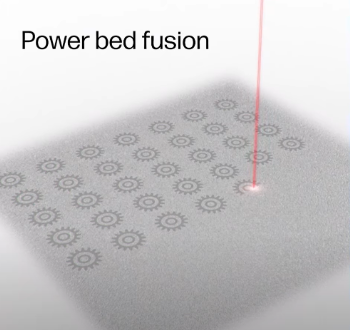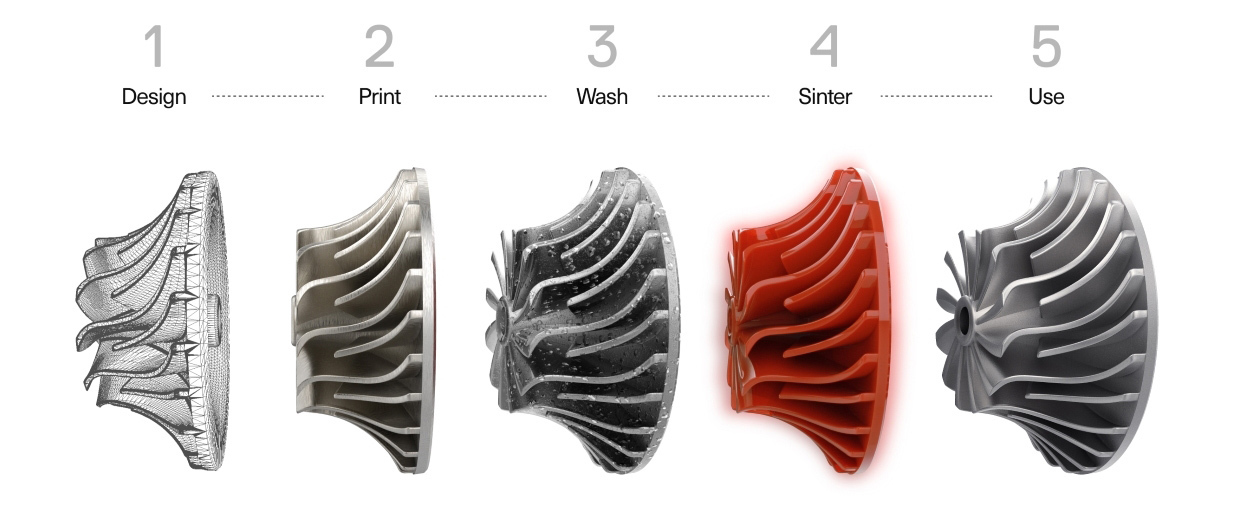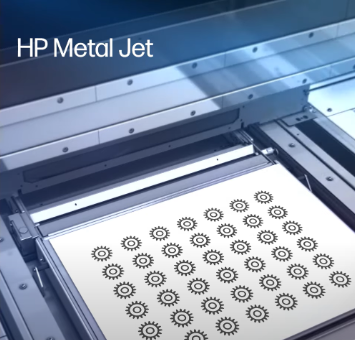Metal powder bed fusion (MPBF) is a 3D printing technology where a high-powered energy source fuses particles of metal powder into complex shapes. MPBF is a popular metal 3D printing technology because it offers a number of advantages over other technologies. There are two forms of MPBF, which differ in terms of the type of energy source they rely on.

Image courtesy of HP.
Electron Powder Bed Fusion
Electron beam powder bed fusion (E-PBF) shines in metal 3D printing with its high-temperature material compatibility, stress-reduced parts, and support-free builds. Yet, its vacuum chamber adds complexity and limits its scope to conductive, high-melting-point metals. While its limitations confine it to specific material families, E-PBF’s ability to print complex internal geometries without supports makes it ideal for medical implants and intricate aerospace components. The unique combination of its strengths – stress-free parts, high-temperature tolerance, and support-free printing – enables engineers to push the boundaries of design and unlock groundbreaking applications in demanding industries.
Laser Powder Bed Fusion
Laser powder bed fusion (LPBF) utilizes a high-powered laser to delicately sinter intricate metal components from a bed of fine metal powder. Unlike its electron beam cousin, LPBF thrives in air or inert gas, making it more accessible and cost-effective. Its diverse material palette welcomes a wide variety of metals, even precious metals. While support structures are often needed for complex geometries, LPBF’s layer-by-layer precision shines in producing lightweight, highly detailed components. From intricate jewelry and dental parts to aerospace structural components. LPBF finds its footing in a broad spectrum of applications where intricate details and diverse materials are required.
Why Companies Choose MPBF
There are a number of reasons why companies choose MPBF to manufacture their parts. Some of the most common include:
- High accuracy and resolution: MPBF can produce parts with very high accuracy and resolution, making it ideal for applications where precise dimensions and tolerances are required.
- Wide range of materials: The technology can also be used to print a wide range of metal materials, including steels, aluminum, titanium, gold, silver, and nickel alloys.
- Complex geometries: MPBF is capable of printing parts with complex geometries that would be difficult or impossible to produce using traditional manufacturing methods.
- Reduced material waste: MPBF results in less waste material compared to conventional techniques, making it potentially more sustainable.
MPBF is ideal for producing parts with complex geometries that would be difficult or impossible to produce using traditional manufacturing methods. This includes parts with internal channels, lattices, and other intricate features.
MPBF can be used to produce parts as soon as the same day, which can help companies to reduce lead times and get their products to market faster—all while using only the required amount of material for the part. Much of the remaining powder can be reused in future prints—not only reducing waste, but allowing for less material to be bought for the production process in general.
Comparing MPBF to Other Metal 3D Printing Techniques
MPBF is one of three primary metal 3D printing technologies, along with metal filament extrusion, binder jetting, and directed energy deposition (DED). Each of these technologies has its own advantages and disadvantages.
Metal Fused Filament Fabrication
Metal fused filament fabrication (MFFF) is a relatively new metal 3D printing technology that is gaining popularity. This technique works by extruding a metal filament through a heated nozzle to create a green state part that must then be washed and sintered in a furnace before reaching full density. MFFF is less expensive than MPBF, but it cannot produce parts with the same level of accuracy and resolution or speed. This is a quick, lower-cost method of producing metal components without going into full scale production.

Image courtesy of Markforged – Showcasing the process of a metal FFF part
Binder Jetting
Binder jetting (BJ) relies on some similar principles to MFFF, in that it results in green parts that require further sintering. The technology sees inkjet printheads deposit a binder onto a layer of metal powder.. Once the part is printed, it is sintered in a furnace to fuse the powder particles together. BJ is less expensive than MPBF, but it cannot produce components with the same level of strength, durability and geometric complexity.

Image courtesy of HP
Directed Energy Deposition
Directed energy deposition (DED) melts metal powder using a high-power laser or electron beam. The molten metal is then deposited onto a build platform to create a part. DED is unable to produce the most complex shapes of any metal AM technology. It is also the slowest and most expensive. Typically, these components require significant post-processing, as the items produced with DED are only near net shape.
Conclusion
MPBF is a versatile and powerful metal 3D printing technology that offers a number of advantages over other technologies. MPBF is ideal for producing high-quality parts with complex geometries, reducing lead times and costs, as well as improving sustainability. If you are considering metal 3D printing for your manufacturing needs, MPBF is a great option to consider.
Feature image courtesy of Protolabs.
Subscribe to Our Email Newsletter
Stay up-to-date on all the latest news from the 3D printing industry and receive information and offers from third party vendors.
You May Also Like
3D Printing News Briefs, April 27, 2024: Research, Digital Dentistry, Cycling, & More
We’re starting today’s 3D Printing News Briefs with some research into 3D printed luminescent quantum-dot polymer architectures and free-form laser beam shaping, and then on to an open source 4-axis...
HP & INDO-MIM Collaborate to Boost Metal 3D Printing in India
HP Inc. and INDO-MIM, a US- and India-based supplier of metal injection molding (MIM) powders and contract manufacturer, have announced that the two companies will collaborate to accelerate additive manufacturing...
3D Printing News Briefs, February 17, 2024: Shot Blasting, Service Bureaus, & More
In today’s 3D Printing News Briefs, we’re starting out with post-processing, as SKZ Würzburg is using a shot blast system from AM Solutions for its research. Moving on to business,...
3D Printing News Unpeeled: Not That Kind of Organ 3D Printing
GKN Aerospace will create a 150 jobs in Trollhattan Sweden with an investment of $60 million part of which comes from the Swedish Energy Agency’s Industriklivet initiative. The investment will...






























